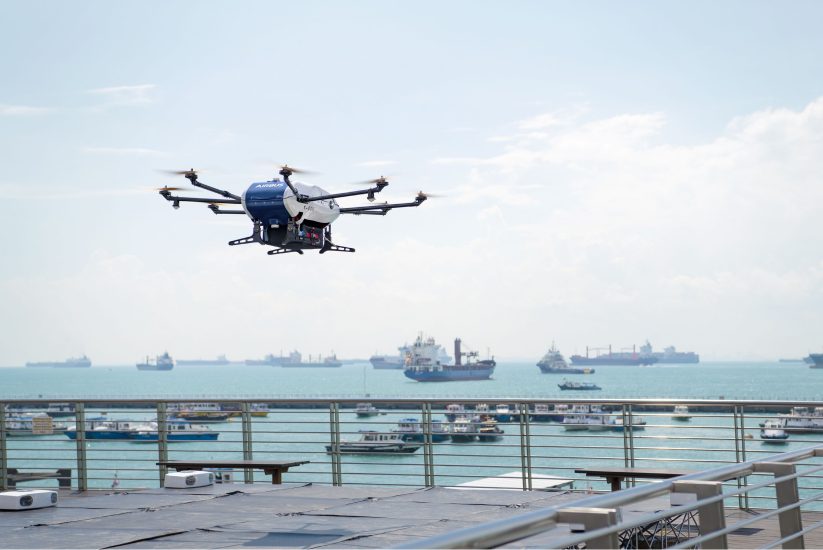To enable efficient and reliable operation of UAS flying in the lower airspace, Airbus together with M1 Limited, embarked on a 5G network connectivity trial with IMDA. Reliable connectivity is an important requirement for the safe operation of UAS and associated systems that manage this traffic in both controlled and uncontrolled airspace.
The purpose of this trial was to assess the suitability of 5G networks as a primary means of communication for UAS operations. It was set up with a two-pronged approach in mind. The first, to determine the viability of using 5G to support the connectivity and communication technology for UAVs. The second was to support the design and development of the world’s first aeronautical and maritime certified standalone 5G modem, aimed at accelerating 5G ecosystem development.
The trial commenced in 2019 at the very nascent stages of 5G standalone architecture (SA), and Airbus is one of the pioneers to run a trial of this nature. It is also Airbus’ first 5G SA trial and was performed at the Maritime Drone Estate set up by IMDA. Due to the pandemic, there have been some delays in this trial study, which will be completed this year.
High safety standards at altitude
Given that safety considerations are of the utmost priority, it was a natural action for Airbus to focus their trial to measure parameters that give an indication of the failure probability.
“The probability of failure gives an indication of reliability,” explains Dr Anoop Kumar Krishna, Head of Airbus Unmanned aerial system Traffic Management (UTM) Lab. “In radio network terms, we look at the connection drops due to radio link failures and the duration of these connection drops before being automatically reconnected.”
“Secured and reliable connectivity is crucial in ensuring that the UAS can operate safely and efficiently during all phases of flight,” adds Dr Anoop. “It is therefore important to measure the 5G signal propagation on airways at different altitudes. The reduced latency of 5G is expected to allow for a more interconnected network, supporting UAV connectivity, remote navigation and surveillance, something that traditional mobile data cannot effectively maintain.”
In this trial, Airbus is in the process of testing 5G SA at different heights and will derive conclusions at the end of their trial. However, Dr Anoop says with the initial results, they have noticed better latency, throughput and handover performance as compared to 4G, and the 5G is a promising candidate to provide reliable connectivity.
“Being able to use 5G for navigation will be a game changer, because the global navigation satellite system (GNSS), which is the common mode of navigation today, still poses some weaknesses, such as accuracy in urban environment,” explains Dr Anoop. This issue of accuracy in localisation can be further addressed using the different methods for localisation provided in the 5G standards together with GNSS.
Sustainable solutions
Currently, existing 4G public terrestrial network base stations have their antennas pointing towards the land mass. This technically makes them less ideal for supporting aerial use cases.
“With the current 4G network we can operate up to 200 feet without any major issues,” Dr. Anoop explains. “However, for many use cases we will have to fly at between 1,000 and 3,000 feet and for that, we are looking at the possibility of leveraging 5G and the capabilities that come with it.”
Through this trial, M1 also noticed a “ducting” effect at higher altitudes, which led to further 5G signal propagation distances, as compared to land-based scenarios. This is because radio signals are trapped by the atmospheric duct and does not spread isotropically7 through the atmosphere.
With 5G SA aerial modems, a key challenge to be addressed is the issue of heat dissipation. The high frequency bands used in 5G, combined with direct exposure to heat radiation, makes it difficult for any customer premises equipment (CPE) to continuously operate without active cooling. The team took this important finding as another learning point to support the development of future devices of this nature. Other improvement considerations include the way antennas on drones are placed, since the angle of antennas would shift the weight balance, affecting the design and flight capabilities.
Commercial aeronautical and maritime certified SA 5G modem
Amidst the interesting findings and new discoveries that this trial is expected to provide, one of the biggest successes that has emerged from this trial is the certification for the world’s first aeronautical and maritime 5G SA modem.
The modem was developed by M1 together with their partner Team One Technologies. They obtained the necessary requirements from Airbus during the development stages of the modem. As a result, the modem passed the DO160 environmental qualification standard, which makes it on par with military grade modems. It meets the stringent criteria that includes level of resistance, shock and vibration, making it durable for use both in the air and on sea. The first of its kind, this modem can perform flawlessly even in harsh environments and extended exposure to elements of water, dust, and heat.
“The certification process took us several months as it had to be sent overseas for stringent testing before getting certified. This is a great milestone achievement for the team, however future innovation such as beamforming antenna for the modem is being considered,” says Denis Seek, Chief Technical Officer at M1.
Future development
Airbus is not new to 5G trials, with collaborations underway across different parts of the world. However, it was only in Singapore that they were presented with the opportunity to do a full 5G SA trial. Since then, a memorandum of understanding (MoU) signed by both Airbus and M1, to collaboratively run 5G SA trials and tests in urban environments, has opened doors to discover and innovate the future of urban air mobility. The findings from the field data collection will help not just Airbus but the industry as they progress in building the future of reliable air
transportation.
For more information visit:




